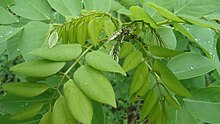Gliricidia
| Gliricidia | |
|---|---|

| |
| Gliricidia sepium | |
| Klasifikasi ilmiah | |
| Domain: | |
| Kerajaan: | |
| Klad: | Tracheophyta |
| Klad: | Angiospermae |
| Klad: | Eudikotil |
| Klad: | Rosid |
| Ordo: | |
| Famili: | |
| Subfamili: | |
| Tribus: | Robinieae
|
| Genus: | Gliricidia Kunth (1842)
|
| Spesies[1][2] | |
| |
| Sinonim[1][2] | |
| |
Gliricidia adalah salah satu genus tumbuhan berbunga dalam keluarga kacang-kacangan (Fabaceae) dan tribus Robinieae. Daerah asalnya adalah Meksiko hingga Peru, tetapi Spesies Gliricidia sepium (Gamal) telah diperkenalkan secara luas ke zona tropis lainnya.[1]
Spesies Gliricidia sepium merupakan pohon hias kecil, meranggas, dibudidayakan, dan digunakan untuk berbagai keperluan di daerah tropis. Nama genusnya berarti "pembunuh tikus", mengacu pada penggunaan tradisional biji beracun dan kulit kayu Gliricidia sepium sebagai rodentisida.[3] Pohonnya tidak berdaun saat berbunga dan berbuah pada bulan April dan Mei di India dan negara-negara dengan iklim yang sama. Bunganya kecil (panjangnya hampir 2 cm), berwarna merah muda pucat, dan tersusun dalam kelompok padat di ranting yang gundul. Bunganya memudar menjadi putih atau ungu samar seiring bertambahnya usia. Bunganya menarik banyak lebah dan beberapa kupu-kupu famili lycaenidae (Terutama spesies Lampides boeticus) dan burung asli lainnya.
Referensi
[sunting | sunting sumber]- ^ a b c Gliricidia Kunth. Plants of the World Online. Retrieved 31 August 2023.
- ^ a b Lavin M, Wojciechowski MF, Gasson P, Hughes C, Wheeler E (2003). "Phylogeny of Robinioid Legumes (Fabaceae) Revisited: Coursetia and Gliricidia Recircumscribed, and a Biogeographical Appraisal of the Caribbean Endemics" (PDF). Systematic Botany. 28 (2): 387–409. doi:10.1043/0363-6445-28.2.387 (tidak aktif 1 August 2023).
- ^ Abulude, F.O; Adebote, V.T. (2009). "Antibacterial investigation of crude extracts of the root bark of Gliricidia sepium". Continental J. Microbiology (3): 23–26.
Text is available under the CC BY-SA 4.0 license; additional terms may apply.
Images, videos and audio are available under their respective licenses.
